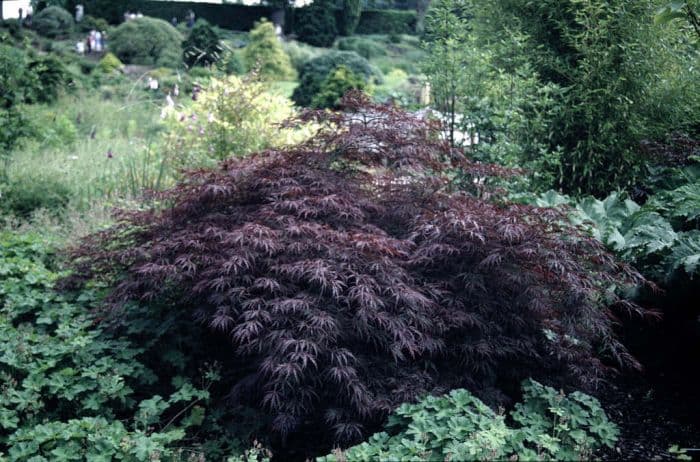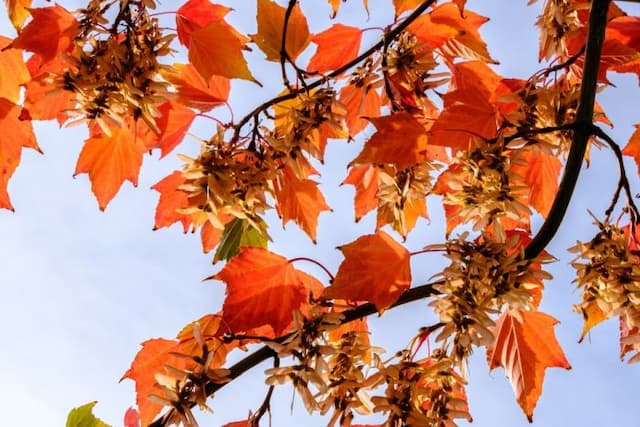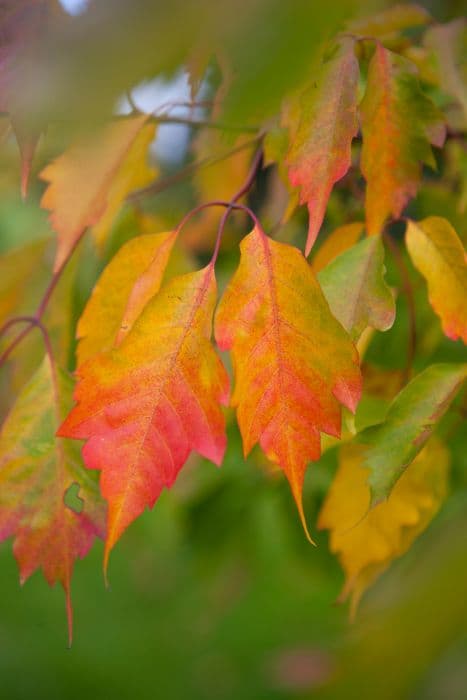Japanese Maple Acer palmatum 'Garnet' (D)

ABOUT
The Japanese Maple 'Garnet' is notable for its beautiful foliage and elegant shape. The leaves are finely dissected, giving them a lace-like appearance and are arranged in a palmate fashion typical of the Japanese Maple. Each leaf comprises several narrow lobes that spread out from a central point like the fingers of a hand. They possess a striking garnet-red color that tends to deepen to a richer crimson shade as the season progresses. During the fall, the leaves take on a fiery display ranging from bright red to sometimes purplish hues before they drop, making this cultivar a standout choice for a show of autumn color. The plant's overall form is gracefully rounded, often with a cascading habit, as the branches tend to weep downwards, giving it a soft, mounded silhouette. The bark, which can become visible particularly in winter when the leaves have fallen, adds to the interest with its smooth texture and subtle coloration that sometimes appears slightly lighter than the foliage. The visual interest of the Japanese Maple 'Garnet' extends over the seasons. In spring, the fresh leaves emerge with a bright and vivid tone, signaling the start of the growing season. During summer, the foliage provides dense canopy, offering a textured visual appeal due to the intricately divided leaves. As temperatures cool, the transformation of the foliage to its autumn colors creates a spectacle that is eagerly awaited by enthusiasts. The Japanese Maple 'Garnet' can serve as a dramatic focal point in a garden setting, blending well with a variety of landscapes due to its distinctive color and form. It's commonly used in themed gardens, such as Japanese or zen gardens, due to its Asian origin and is also perfect for adding structure or color contrast in mixed borders.
About this plant
 Names
NamesFamily
Sapindaceae.
Synonyms
Japanese Maple, Garnet Japanese Maple, Laceleaf Japanese Maple, Cutleaf Japanese Maple, Threadleaf Japanese Maple, Dissectum Maple.
Common names
Acer palmatum 'Garnet'
 Toxicity
ToxicityTo humans
The Japanese maple is generally not considered toxic to humans. There are no widely recognized or common symptoms associated with poisoning from this plant, as it is not known to be poisonous upon ingestion of any part.
To pets
The Japanese maple is also not considered toxic to pets. It should not cause any symptoms of poisoning in animals if they ingest parts of the plant, as it is not recognized as a poisonous species for household pets.
 Characteristics
CharacteristicsLife cycle
Perennials
Foliage type
Deciduous
Color of leaves
Burgundy
Height
6-10 feet (1.8-3 meters)
Spread
6-10 feet (1.8-3 meters)
Plant type
Tree
Hardiness zones
5-8
Native area
Japan
Benefits
 General Benefits
General Benefits- Ornamental Appeal: Japanese Maple 'Garnet' is highly valued for its beautiful, deeply dissected dark red leaves, adding strong visual interest to gardens.
- Seasonal Color: This cultivar offers a changing palette throughout the seasons, with colorful spring foliage, vibrant autumn leaves, and interesting winter branch patterns.
- Shade Creation: Japanese Maples can provide dappled shade that cools spaces and creates comfortable outdoor areas.
- Landscape Versatility: Acer palmatum 'Garnet' can be planted in a variety of landscape settings including patios, entrances, or as a focal point in gardens.
- Wildlife Attraction: While not specifically known for wildlife benefits, Japanese Maples can attract birds and beneficial insects that find refuge in their branches.
- Small Size: Its relatively small size makes it suitable for smaller gardens or spaces, and it can even be grown in containers.
- Low Maintenance: This maple variety is generally low-maintenance, requiring minimal pruning and care once established.
 Medical Properties
Medical PropertiesThis plant is not used for medical purposes.
 Air-purifying Qualities
Air-purifying QualitiesThis plant is not specifically known for air purifying qualities.
 Other Uses
Other Uses- Photography and Art: Japanese Maple is often used as a subject for photography and paintings due to its intricate foliage and beautiful fall colors, providing inspiration and material for artists.
- Bonsai: The 'Garnet' variety, like many Japanese Maples, can be trained as a bonsai tree, making it a popular choice for enthusiasts of this miniature tree art form.
- Feng Shui: In Feng Shui, the Japanese Maple, due to its harmonious structure, is used to enhance the flow of Qi in garden spaces, believed to bring positive energy.
- Educational Tool: Horticulture students often use Japanese Maples to learn about pruning techniques and tree physiology as these trees clearly show the results of various pruning methods over time.
- Wedding Decor: Branches of Japanese Maple are sometimes used in floral arrangements and wedding decor for their unique, deeply cut leaves and their vibrant colors.
- Theme Gardens: They are used in thematic gardens, such as Japanese Zen gardens, for creating a specific atmosphere or replicating a style from a particular region or culture.
- Culinary Presentation: The leaves of Japanese Maple, especially when they turn vibrant colors, can be used as a natural garnish or decoration on food platters, adding an aesthetic touch.
- Film and Theatre: Japanese Maples might be used as part of set designs in film or theatre productions to create an Asian ambiance or depict a particular season.
- Crafting: Dried leaves of the Japanese Maple can be lacquered and used in crafting, such as making bookmarks or adding to handmade paper for textural interest.
- Relaxation Spaces: The calming presence of Japanese Maple trees is often incorporated into planning spaces like spas or retreat centers to contribute to a tranquil environment.
Interesting Facts
 Feng Shui
Feng ShuiThe Japanese Maple is not used in Feng Shui practice.
 Zodiac Sign Compitability
Zodiac Sign CompitabilityThe Japanese Maple is not used in astrology practice.
 Plant Symbolism
Plant Symbolism- Beauty and Elegance: The Japanese Maple 'Garnet' is known for its graceful form and stunning foliage, symbolizing natural beauty and sophistication.
- Change and Transformation: As a tree that displays vibrant color changes throughout the seasons, it represents the idea of transformation and the ever-changing nature of life.
- Calmness and Peace: The tranquil appearance of the Japanese Maple makes it a symbol of serenity and meditative calmness.
- Endurance and Strength: Despite its delicate appearance, the Japanese Maple 'Garnet' is quite hardy, symbolizing inner strength and the ability to endure challenges.
- Balance and Harmony: The balanced, symmetrical growth pattern of 'Garnet' reflects the Japanese aesthetic of balance and can represent the pursuit of harmony in life.
 Water
WaterJapanese Maple 'Garnet' should be watered deeply when the top few inches of soil are dry, which typically amounts to once or twice a week depending on the weather and soil drainage. Water should be applied directly to the base of the plant, avoiding wetting the leaves to prevent fungal diseases. During hot or dry spells, increase the frequency of watering to prevent stress. A young tree may need about 10 to 15 gallons of water per week, while an established tree requires less frequent watering since it has a more extensive root system to access soil moisture.
 Light
LightJapanese Maple 'Garnet' thrives best in dappled or partial shade, especially in regions with hot summers. It can tolerate morning sun with afternoon shade or full sun in cooler climates. A spot protected from harsh afternoon sun will help preserve the foliage's vibrant colors while avoiding leaf scorch.
 Temperature
TemperatureJapanese Maples, including 'Garnet', prefer a temperate climate with temperatures ranging roughly from 15°F in the winter to 85°F in the summer. They can withstand short periods of colder temperatures down to -10 to -20°F, but prolonged exposure can be harmful. The ideal growing temperature for 'Garnet' Japanese Maple is between 60°F and 70°F.
 Pruning
PruningPrune Japanese Maple 'Garnet' primarily to maintain its natural shape, remove any dead or damaged branches, and to encourage healthy growth. Pruning is best done in the late winter or early spring before new growth begins. Thin out the canopy to allow light and air to reach all parts of the plant. Pruning can also be done in summer after the leaves fully develop to correct any growth issues.
 Cleaning
CleaningAs needed
 Soil
SoilJapanese Maple 'Garnet' thrives in a well-draining soil mix that is rich in organic matter. A good mix would be one-third peat moss, one-third pine bark, and one-third coarse sand or perlite. The ideal soil pH for Japanese Maple 'Garnet' is slightly acidic, ranging from 5.5 to 6.5.
 Repotting
RepottingJapanese Maple 'Garnet' should be repotted every two to three years, preferably in the early spring before the growing season begins. Repotting is necessary when the tree becomes root-bound or the soil is exhausted.
 Humidity & Misting
Humidity & MistingJapanese Maple 'Garnet' prefers average humidity levels. Outdoor conditions often provide sufficient humidity, and no special requirements are needed unless the plant is grown in an unusually dry environment.
 Suitable locations
Suitable locationsIndoor
Place in bright, indirect light; keep away from heat sources.
Outdoor
Plant in dappled shade, protect from strong winds.
Hardiness zone
5-8 USDA
 Life cycle
Life cycleThe Japanese Maple 'Garnet' begins its life as a seed, which under suitable conditions, germinates in the spring, requiring moisture and a period of stratification to break dormancy. The seedling emerges and produces its first leaves, which are typically green, gradually developing the characteristic red foliage as it matures. The sapling stage follows, as the tree slowly grows and establishes a strong root system. Over several years, the Japanese Maple 'Garnet' reaches maturity, developing a distinctive, often cascading form with finely dissected, garnet-colored leaves that undergo a seasonal change to bright red or orange in the autumn. The mature tree produces small purple-red flowers in spring, which may lead to the development of winged samaras, or seeds, that disperse in the wind. With proper care, this slow-growing, ornamental tree can live several decades, contributing to the landscape with its striking color and form throughout its lifespan.
 Propogation
PropogationPropogation time
Spring-Early Summer
The Japanese Maple 'Garnet' is typically propagated by softwood cuttings during the early summer months when new growth is still flexible. To do this, a cutting about 4 to 6 inches (10 to 15 centimeters) long is taken from a healthy branch, with the leaves removed from the lower half. The cut end is then dipped in rooting hormone to encourage root development and planted in a mix of peat and perlite to provide adequate drainage and aeration. The cutting should be kept in high humidity, using a plastic cover if necessary, and in indirect light until roots have formed, which can take several weeks. Regular misting can help maintain the necessary humidity levels, but it's crucial not to overwater as this can cause the cutting to rot. Once the roots have developed, the new plant can be potted in soil and gradually acclimated to less humid conditions.









